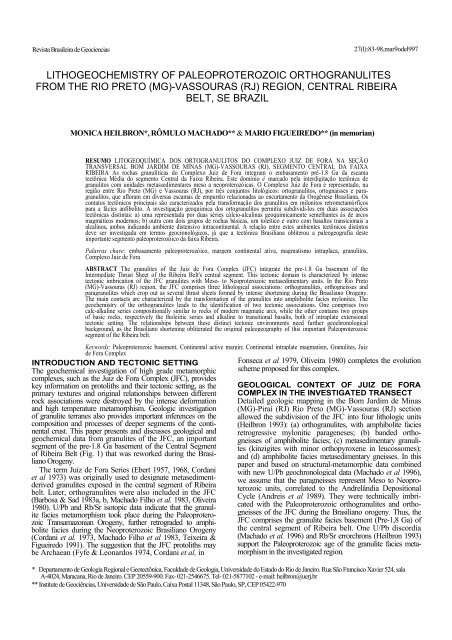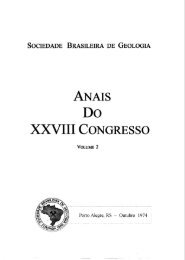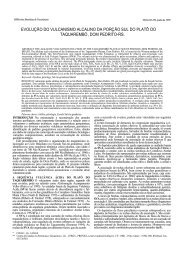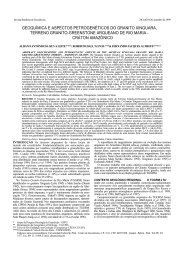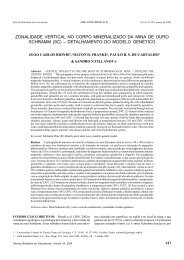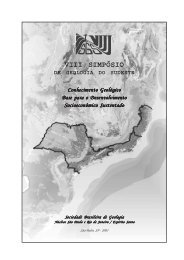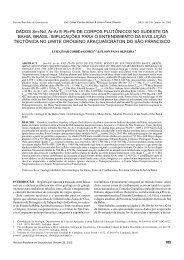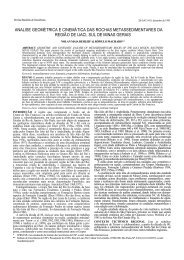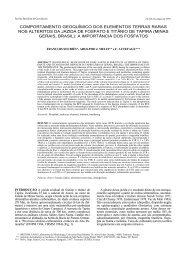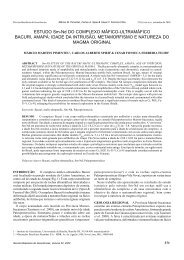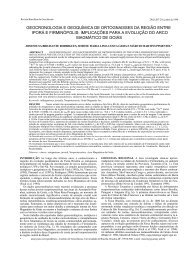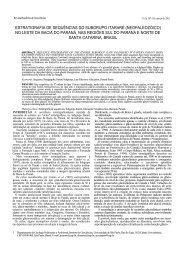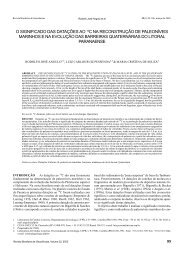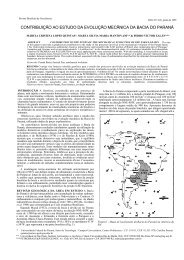(mg)-vassouras (rj) - Sociedade Brasileira de Geologia
(mg)-vassouras (rj) - Sociedade Brasileira de Geologia
(mg)-vassouras (rj) - Sociedade Brasileira de Geologia
You also want an ePaper? Increase the reach of your titles
YUMPU automatically turns print PDFs into web optimized ePapers that Google loves.
Revista <strong>Brasileira</strong> <strong>de</strong> Geociencias<br />
LITHOGEOCHEMISTRY OF PALEOPROTEROZOIC ORTHOGRANULITES<br />
FROM THE RIO PRETO (MG)-VASSOURAS (RJ) REGION, CENTRAL RIBEIRA<br />
BELT, SE BRAZIL<br />
MONICA HEILBRON*, RÔMULO MACHADO** & MARIO FIGUEIREDO** (in memorian)<br />
RESUMO LITOGEOQUÍMICA DOS ORTOGRANULITOS DO COMPLEXO JUIZ DE FORA NA SEÇÃO<br />
TRANSVERSAL BOM JARDIM DE MINAS (MG)-VASSOURAS (RJ), SEGMENTO CENTRAL DA FAIXA<br />
RIBEIRA As rochas granulíticas do Complexo Juiz <strong>de</strong> Fora integram o embasamento pré-1.8 Ga da escama<br />
tectônica Média do segmento Central da Faixa Ribeira. Este domínio é marcado pela interdigitação tectônica <strong>de</strong><br />
granulitos com unida<strong>de</strong>s metassedimentares meso a neoproterozóicas. O Complexo Juiz <strong>de</strong> Fora é representado, na<br />
região entre Rio Preto (MG) e Vassouras (RJ), por três conjuntos Iitológicos: ortogranulitos, ortognaisses e paragranulitos,<br />
que afloram em diversas escamas <strong>de</strong> empurrão relacionadas ao encurtamento da Orogênese Brasiliana. Os<br />
contatos tectônicos principais são caracterizados pela transformação dos granulitos em milonitos retrometamórficos<br />
para a fácies anfibolito. A investigação geoquímica dos ortogranulitos permitiu subdividi-los em duas associações<br />
tectônicas distintas: a) uma representada por duas séries cálcio-alcalinas geoquimicamente semelhantes às <strong>de</strong> arcos<br />
magmáticos mo<strong>de</strong>rnos; b) outra com dois grupos <strong>de</strong> rochas básicas, urn toleítico e outro com basaltos transicionais a<br />
alcalinos, ambos indicando ambiente distensivo intracontinental. A relação entre estes ambientes tectônicos distintos<br />
<strong>de</strong>ve ser investigada em termos geocronológicos, já que a tectônica Brasiliana obliterou a paleogeografia <strong>de</strong>ste<br />
importante segmento paleoproterozóico da faixa Ribeira.<br />
Palavras chave: embasamento paleoproterozóico, margem continental ativa, magmatismo intraplaca, granulitos,<br />
Complexo Juiz <strong>de</strong> Fora<br />
ABSTRACT The granulites of the Juiz <strong>de</strong> Fora Complex (JFC) integrate the pre-1.8 Ga basement of the<br />
Intermediate Thrust Sheet of the Ribeira Belt's central segment. This tectonic domain is characterized by intense<br />
tectonic imbrication of the JFC granulites with Meso- to Neoproterozoic metasedimentary units. In the Rio Preto<br />
(MG)-Vassouras (RJ) region, the JFC comprises three lithological associations: orthogranulites, orthogneisses and<br />
paragranulites which crop out as several thrust sheets formed by intense shortening during the Brasiliano Orogeny.<br />
The main contacts are characterized by the transformation of the granulites into amphibolite facies mylonites. The<br />
geochemistry of the orthogranulites leads to the i<strong>de</strong>ntification of two tectonic associations. One comprises two<br />
calc-alkaline series compositionally similar to rocks of mo<strong>de</strong>rn magmatic arcs, while the other contains two groups<br />
of basic rocks, respectively the tholeiitic series and alkaline to transitional basalts, both of intraplate extensional<br />
tectonic setting. The relationships between these distinct tectonic environments need further geochronological<br />
background, as the Brasiliano shortening obliterated the original paleogeography of this important Paleoproterozoic<br />
segment of the Ribeira belt.<br />
Keywords: Paleoproterozoic basement, Continental active margin; Continental intraplate magmatism, Granulites, Juiz<br />
<strong>de</strong> Fora Complex<br />
INTRODUCTION AND TECTONIC SETTING<br />
The geochemical investigation of high gra<strong>de</strong> metamorphic<br />
complexes, such as the Juiz <strong>de</strong> Fora Complex (JFC), provi<strong>de</strong>s<br />
key information on protoliths and their tectonic setting, as the<br />
primary textures and original relationships between different<br />
rock associations were <strong>de</strong>stroyed by the intense <strong>de</strong>formation<br />
and high temperature metamorphism. Geologic investigation<br />
of granulite terranes also provi<strong>de</strong>s important inferences on the<br />
composition and processes of <strong>de</strong>eper segments of the continental<br />
crust. This paper presents and discusses geological and<br />
geochemical data from granulites of the JFC, an important<br />
segment of the pre-1.8 Ga basement of the Central Segment<br />
of Ribeira Belt (Fig. 1) that was reworked during the Brasiliano<br />
Orogeny.<br />
The term Juiz <strong>de</strong> Fora Series (Ebert 1957, 1968, Cordani<br />
et al 1973) was originally used to <strong>de</strong>signate metasediment<strong>de</strong>rived<br />
granulites exposed in the central segment of Ribeira<br />
belt. Later, orthogranulites were also inclu<strong>de</strong>d in the JFC<br />
(Barbosa & Sad 1983a, b, Machado Filho et al. 1983, Oliveira<br />
1980). U/Pb and Rb/Sr isotopic data indicate that the granulite<br />
facies metamorphism took place during the Paleoproterozoic<br />
Transamazonian Orogeny, further retrogra<strong>de</strong>d to amphibolite<br />
facies during the Neoproterozoic Brasiliano Orogeny<br />
(Cordani et al. 1973, Machado Filho et al 1983, Teixeira &<br />
Figueiredo 1991). The suggestion that the JFC protoliths may<br />
be Archaean (Fyfe & Leonardos 1974, Cordani et al, in<br />
27(l):83-98,mar9o<strong>de</strong>l997<br />
Fonseca et al 1979, Oliveira 1980) completes the evolution<br />
scheme proposed for this complex.<br />
GEOLOGICAL CONTEXT OF JUIZ DE FORA<br />
COMPLEX IN THE INVESTIGATED TRANSECT<br />
Detailed geologic mapping in the Bom Jardim <strong>de</strong> Minas<br />
(MG)-Piraí (RJ) Rio Preto (MG)-Vassouras (RJ) section<br />
allowed the subdivision of the JFC into four lithologic units<br />
(Heilbron 1993): (a) orthogranulites, with amphibolite facies<br />
retrogressive mylonitic parageneses; (b) ban<strong>de</strong>d orthogneisses<br />
of amphibolite facies; (c) metasedimentary granulites<br />
(kinzigites with minor orthopyroxene in leucossomes);<br />
and (d) amphibolite facies metasedimentary gneisses. In this<br />
paper and based on structural-metamorphic data combined<br />
with new U/Pb geochronological data (Machado et al 1996),<br />
we assume that the paragneisses represent Meso to Neoproterozoic<br />
units, correlated to the Andrelândia Depositional<br />
Cycle (Andreis et al 1989). They were technically imbricated<br />
with the Paleoproterozoic orthogranulites and orthogneisses<br />
of the JFC during the Brasiliano orogeny. Thus, the<br />
JFC comprises the granulite facies basement (Pre-1,8 Ga) of<br />
the central segment of Ribeira belt. One U/Pb discordia<br />
(Machado et al. 1996) and Rb/Sr errorchrons (Heilbron 1993)<br />
support the Paleoproterozoic age of the granulite facies metamorphism<br />
in the investigated region.<br />
* Departamento <strong>de</strong> <strong>Geologia</strong> Regional e Geotectônica, Faculda<strong>de</strong> <strong>de</strong> <strong>Geologia</strong>, Universida<strong>de</strong> do Estado do Rio <strong>de</strong> Janeiro. Rua São Francisco Xavier 524, sala<br />
A-4024, Maracana, Rio <strong>de</strong> Janeiro. CEP 20559-900. Fax- 021-2546675. Tel- 021-5877102 - e-mail: heilbron@ue<strong>rj</strong>.br<br />
** Institute <strong>de</strong> Geociências, Universida<strong>de</strong> <strong>de</strong> São Paulo, Caixa Postal 11348, São Paulo, SP, CEP 05422-970
84<br />
Revista <strong>Brasileira</strong> <strong>de</strong> Geociencias, Volume 27,1997<br />
Figure 1 - (a) - Simplified tectonic map of southeastern Brazil, compiled and integrated from Hasui & Oliveira (1984), Campos<br />
Neto (1992), Valeriano (1992),and Trouw & Castro (1996). The inset shows the location of the central segment of Ribeira Belt.<br />
Legend: 1- Phanerozoic cover, a -Parana basin; b, c, d and e - Taubate, Resen<strong>de</strong>, Volta Redonda and Guanabara rifts; 2- Bambui<br />
Group, 3 -cratonic basement, 4 -Brasiliano fold belts (ARGD- Alto Rio Gran<strong>de</strong> Domain); 5 - Guaxupe nappe; 6 - Limit of the São<br />
Francisco Craton.(b) - Tectonic compartments of the central segment of Ribeira Fold Belt (Heilbron 1993,1995). Legend: 1- São<br />
Francisco craton; 2 - autochthonous domain; 3 - lower domain; 4 - intermediate domain; 5 - upper domain; 6 - Meso-Cenozoic<br />
alkaline rocks; 7 - Phanerozoic cover; 8 -Major thrust shear zones; 9 - Major late <strong>de</strong>formation axial traces; 10 - brittle<br />
phanerozoic faults; 11 - Towns (SJ- São Joao <strong>de</strong>l Rei, AN- Andrelândia, BP- Barra do Piraí); 12-Location of the investigated<br />
transect of figure 2.<br />
Figure 1 - (a) - Mapa tectonico simplificado da região su<strong>de</strong>ste brasileira, compilado e integrado <strong>de</strong> Hasui & Oliveira (1984), Campos Neto (1992), Valeriano (1992)<br />
e Trouw & Castro. (1996). O paralelogramo localiza o segmento central da Faixa Ribeira. Legenda: 1 - Cobertura fanerozóica, a - Bacia do Paraná; <strong>de</strong> d a f,<br />
respectivamente, rifts <strong>de</strong> Taubaté, Resen<strong>de</strong>, Volta Redonda e da Guanabara; 2 - Grupo Bambuí; 3 - Embasamento cratônico; 4 - Faixas dobradas brasilianas (ARGD<br />
- Domínio Alto Rio Gran<strong>de</strong>); 5 - Nappe Guaxupé; 6 - Limite do Cráton do São Francisco, (b) - Compartimentação tectônica do segmento central da Faixa Ribeira<br />
(Heilbron 1993,1995). Legenda: 1 -Cráton do São Francisco; 2 - Domínio Autóctone; 3 - Domínio Inferior; 4 - Domínio Médio; 5 - Domínio Superior; 6 -Rochas<br />
alcalinas meso-cenozóicas; 7 - Cobertura fanerozóica; 8 - Principais empurrões; 9 - Principais traços axiais do redobramento tardio; 10 - Falhas rúpteis fanerozóicas,<br />
11 -Cida<strong>de</strong>s (SJ- São Jão <strong>de</strong>l Rei, NA - Andrelândia, BP - Barra do Piraí), 12 - Área investigada em <strong>de</strong>talhe, apresentada na figura 2.<br />
Figure 2 shows that the orthogranulites of the JFC crop out<br />
as three major tectonic thrust sheets. Their contacts are important<br />
shear zones, characterized by retrogressive amphibolite<br />
facies mylonitic textures and tectonic mixing with the Meso<br />
to Neoproterozoic cover. Within the thrust sheets, coarse<br />
granoblastic textures with green feldspars predominate.<br />
Along the transect, granulites with intermediate composition<br />
are the most abundant rocks of the JFC, but many visited<br />
outcrops show acidic and basic types, except at the basal<br />
section of the upper granulite thrust sheet (Fig. 2), which<br />
consists of basic tholeiitic rocks. Locally, granulites display<br />
relict migmatitic structures.<br />
Ortho and clinopyroxene, hornblen<strong>de</strong>, quartz and antiperthitic<br />
plagioclase are major minerals of the orthogranulites,<br />
with minor garnet and biotite. K-feldspar is restricted to the<br />
acid terms (Table 1). Zircon, apatite, monazite, and ilmenite<br />
are accessories. Retrogressive reactions, such as hornblen<strong>de</strong><br />
and biotite rims and lamellae around and within the pyroxene<br />
crystals are common, mainly along major Brasiliano shear<br />
zones, where the granulites are transformed into ban<strong>de</strong>d<br />
mylonite-gneisses.<br />
The JFC orthogneisses (Fig. 2) are <strong>de</strong>formed acid to basic<br />
igneous rocks metamorphosed un<strong>de</strong>r amphibolite facies. The<br />
geochemistry of these orthogneisses will not be consi<strong>de</strong>red in<br />
this paper, but they probably represent the igneous protoliths<br />
of the granulites.<br />
The paragranulites of the JFC (Fig. 2) are kinzigites with<br />
orthopyroxene-bearing leucossomes. They also occur in the<br />
studied transect, but are restricted to the basal thrust sheet<br />
(Fig. 2). Eastwards, nearby the city of Juiz <strong>de</strong> Fora, the<br />
paragranulites of the JFC become more abundant (Duarte et<br />
al. 1994). The kinzigites are ma<strong>de</strong> up of garnet, sillimanite,<br />
biotite, plagioclase, quartz, and minor K-feldspar and orthopyroxene.<br />
GEOCHEMISTRY Previous results Oliveira<br />
(1980,1982) presented geochemical data of the JFC rocks<br />
and conclu<strong>de</strong>d that these rocks belong to differentiated calc-
Revista <strong>Brasileira</strong> <strong>de</strong> Geociencias, Volume 27,1997<br />
Figure 2 - Detailed geological map of the Rio Preto (MG) - Vassouras (RJ) region, with the location of the analysed granulite<br />
samples. Legend: 1 - S-type Brasiliano granitoids; 2 - I-type Brasiliano granitoids; 3 - Andreldndia <strong>de</strong>positional cycle<br />
discriminating major quartzite layers; 4 - Mantiqueira complex; 5 - Paragranulites of JFC (?); 6 - Orthogranulites of JFC; 1 -<br />
Hornblen<strong>de</strong> orthogneisses of JFC; 8 - Paraíba do Sul group or complex; 9 - Quirino complex; 10 - Major thrust shear- zones<br />
limiting the Lower, Intermediate and Upper tectonic domains; 11 - Subordinated thrusts; 12 - Subvertical faults; 13 - Sample<br />
location; 14 - Normal faults; 15 - Resen<strong>de</strong> basin.<br />
Figura 2 - Mapa geológico <strong>de</strong>talhado da Região entre Rio Preto(MG) e Vassouras (RJ), com a localização das amostras estudadas. Legenda - 1 -Granitói<strong>de</strong>s<br />
brasilianos tipo-S; 2 - Granitói<strong>de</strong>s brasilianos Tipo-I; 3 -Ciclo Deposicional Andrelândia com bancos quartzíticos individualizados; 4 - Complexo Mantiqueira; 5<br />
-Paragranulitos do CJF (?); 6 - Ortogranulitos do CJF; 7 -Hornblenda ortognaisses do CJF; 8 - Complexo Paraíba do Sul; 9 - Complexo Quirino; 10 - Principais<br />
empurrões basais dos domímios tectônicos Médio e Superior; 11 - Empurrões subordinados; 12 - Falhas subverticais; 13 - Localização das amostras; 14 - Falhas<br />
normais e 15 - Bacia <strong>de</strong> Resen<strong>de</strong><br />
alkaline series, with <strong>de</strong>pletion of Rb and slight enrichment of<br />
Zr, Sr and Ba as compared to the average upper crust composition.<br />
The author also proposed that the granulites represent<br />
an alkali <strong>de</strong>pleted residue of extensive anatexis.<br />
Machado Filho et al. (1983) subdivi<strong>de</strong>d the JFC into orthoand<br />
paragranulites, the former belonging both to the calcalkaline<br />
and tholeiitic series. The calc-alkaline orthogranulites<br />
was intepreted as representing lower crust samples,<br />
while the tholeiitic granulites were correlated to an Archean<br />
basaltic crust. The calc-alkaline and tholeiitic nature of the<br />
JFC granulites were also recognized by Barbosa & Sad (1983<br />
a, b) and Sad & Barbosa (1985). The authors suggest that the<br />
calc-alkaline granulites may represent either metasedimentary<br />
rocks or injection of a acid magma within the basic rocks,<br />
while the tholeiitic samples characterize a mafic oceanic<br />
crust.<br />
Figueiredo & Campos Neto (1993) and Campos Neto &<br />
Figueiredo (1990) discuss geochemical data of the northern<br />
segment of the JFC in the Rio <strong>de</strong> Janeiro state, and <strong>de</strong>scribe<br />
the occurrence of Orthogranulites (Itaperuna-Comendador<br />
Venancio unit) and amphibolite facies orthogneisses (Sao<br />
João do Paraíso unit) with calc-silicate inclusions. The analytical<br />
data of both units are similar and indicate two calc-<br />
alkaline series. One is represented by a large compositional<br />
variety of rocks, enriched in Mg, Ca and Cr, and with slightly<br />
fractionated chondrite REE normalized patterns. The other is<br />
enriched in LILE, with higher Fe, Ti, K, Rb, Ba, Nb, Zr and<br />
HREE contents, and more fractionated chondrite normalized<br />
REE patterns with negative Eu anomaly.<br />
Sampling Based on field and petrographic data (Table<br />
1), 37 samples of granulites were selected for chemical analyses.<br />
The location of the sampled outcrops is shown in figure<br />
2. The analyses were performed at Geosol-Geolab Division<br />
Laboratory, Brazil. Si, Al, Ti, Ca, Fe tot , P, and trace elements<br />
were analysed by XRF, while Mn, Ca, Na, K, and Mg by<br />
atomic absorption, Fe 2+ by wet chemical analysis, and REE<br />
by fusion-ICP. The analytical results are in Tables 2 to 4.<br />
Chemical discrimination and tectonic settings<br />
The studied granulites subdivi<strong>de</strong> into two groups<br />
of acid to intermediate composition (Table 2 and 3) and two<br />
groups of basic composition (Table 4).<br />
ACID TO INTERMEDIATE GRANULITES These<br />
granulites comprise two geochemical groups, named CAS1<br />
85
86<br />
Revista <strong>Brasileira</strong> <strong>de</strong> Geociencias, Volume 27,1997<br />
Table 1- Simplified mineralogy of the granulites of the Juiz <strong>de</strong> Fora Complex, subdivi<strong>de</strong>d into distinctive geochemical groups.<br />
Mineral abbreviations: OPX- orthopyroxene; CPX-clinopyroxene; HBL- hornblen<strong>de</strong>; BIO- biotite; PLAG-plagiodase; QZquartz;<br />
KF- alcali-feldspar; ZIR- zircon; AP- apatite; GAR- garnet; OP- opaque minerals<br />
Tabela 1- Mineralogia simplicada dos granulitos do Complexo Juiz <strong>de</strong> Fora, subdivididos pelos diferentes grupos geoquímicos.<br />
and CAS2, which probably belong to different calc-alkaline<br />
series (Figs. 3a and 3b). They are metaluminous rocks with<br />
Shand's in<strong>de</strong>x below 1 (Fig. 3c). Their chemical composition<br />
classification, also corroborated by petrographic data, indicate<br />
the predominance of intermediate (en<strong>de</strong>rbitic) rocks, as<br />
shown in the Alk x SiO2 diagram of Le Maitre (1989) and in<br />
the Middlemost (1985) diagram (Figs. 3d and 3e), and by the<br />
QAP normative diagram (Fig. 3f).<br />
The CAS1 samples belong to a medium-K calc-alkaline<br />
series (open circles in all diagrams). It is the most expan<strong>de</strong>d<br />
series and inclu<strong>de</strong>s gabbrodiorite, diorite, tonalite, granodiorite<br />
and one granite sample (Figs. 3d to 3f)- As compared<br />
to the CAS2 series (open squares), discussed below, the<br />
CAS1 is relatively enriched in compatible elements (CaO,<br />
MgO, FeO*, MnO, Cr), and HFS elements (e.g. TiO2, P2O5),<br />
as shown respectively in figures 4a and 4b. In spite of the<br />
LILE scatter relative to SiO2 (Fig. 4c), probably due to metamorphic<br />
remobilization during the Brasiliano Cycle, the<br />
CAS1 samples generally have lower contents in these elements.<br />
REE normalized to chondrite are more enriched but<br />
less fractionated then the CAS2 (Figs. 5a, 5b), show large<br />
negative Eu anomalies (Eu/Eu* between 0.35 and 0.80), and<br />
the HREE content <strong>de</strong>creases with differentiation (Fig. 5a).<br />
The CAS1 rocks also show the lowest Rb/Sr and the highest<br />
Sm/Nd ratios. Two samples (VAL-IV-23, VAL-593), represented<br />
by half-filled circles in the Harker diagrams (Figs. 4a<br />
to 4c), have some chemical similarities with CAS 1, but their<br />
chondrite normalized REE pattern is more fractionated, lack<br />
negative Eu anomaly (Eu/Eu* ≈ 1) , and have higher Cr<br />
contents.<br />
The CAS2 samples (open squares) belong to a high-K<br />
calc-alkaline series, with granites, and minor granodiorites<br />
and monzodiorites, containing up to 4.1% K2O (Fig. 3d to<br />
3f). As compared to the CAS1, the CAS2 samples are <strong>de</strong>pleted<br />
in HFSE and particularly in compatible elements, except<br />
Ni (Fig. 4a, b). This group is also enriched in LILE,<br />
especially K2O, Rb and Sr (Fig. 4c), and is richer in Al2O3.<br />
Chondrite-normalized REE abundances display higher fractionation<br />
(Fig. 5c), with substantial <strong>de</strong>pletion in HREE and<br />
positive Eu anomalies (Eu/Eu* up to 1.4). This group also has<br />
higher K/Rb, Rb/Sr, K/Ba, and La/Sm ratios, consistent with<br />
the LILE enrichment. U/Pb data on zircons from acid<br />
granulites of outcrop 44, located near the town of Conservatoria<br />
(Fig. 2), <strong>de</strong>fine a discordia with intercepts at 2134 and<br />
579 Ma, while monazite from the same sample is concordant<br />
at 563 Ma (Machado et al. 1996). Field relationships indicate<br />
that CAS2 is intrusive in CAS 1 and B2 basic group (<strong>de</strong>scribed<br />
below), which also integrate the JFC.<br />
Three samples (half-filled squares) show enrichment in<br />
LREE (Fig. 5d) and highly fractionated REE chondritenormalized<br />
signature. When compared with the rest of CAS2<br />
samples, they also display enrichment in some HFS elements<br />
(e.g. Y, Zr, P2O5), and in Ba and Cr, and have very low Ni<br />
contents (Figs. 4a, 4b and 4c). Due to the small number of<br />
samples, the distinct chemical composition of three samples<br />
might be due either to a distinct calc-alkaline group or to<br />
magmatic differentiation.<br />
The plot of the CAS1 and CAS2 samples in tectonic<br />
discrimination diagrams, such as Rb x Y+Nb (Pearce et al.<br />
1984) suggest a volcanic arc setting (Fig. 6). The Rl x R2<br />
(Batchelor & Bow<strong>de</strong>n 1985) diagram suggests that the CAS1<br />
rocks may have been <strong>de</strong>rived from pre-collisional granitoids,<br />
while the CAS 2 rocks represent late- to post-collisional granitoids<br />
(Fig. 7). The K2O x SiO2 diagram (le Maitre 1989)<br />
and the log CaO/Alk x SiO2 diagram (Brown 1982), not<br />
shown in this paper, are also suggestive of a progressive<br />
chemical maturity from the CAS1 to the CAS2 group, as<br />
observed in mo<strong>de</strong>rn compressive settings, with enrichment in<br />
Alk and in the total LILE. The multielemental diagrams such<br />
as the Ocean Ridge Granite normalized spi<strong>de</strong>rgrams (Fig. 8)<br />
of Pearce et al. (1984), are also consistent with magmatic arc<br />
settings.<br />
Sample CJE-44-6b (asterisk) is a leucossome associated<br />
with alkaline to transitional basic rocks of B2 group (see<br />
below). As the other samples of this group, it shows very high<br />
contents of HFS elements.<br />
BASIC GRANULITES The basic rocks of the JFC (Table<br />
4) show some compositional dispersion, even within a<br />
small number of samples. They are tentatively subdivi<strong>de</strong>d in<br />
two groups.<br />
The Bl group (triangles) is characterized by low-TiO2 -<br />
P2O5 tholeiitic basic rocks (Figs. 9 to 12) and one ultrabasic<br />
sample (CPH-118). The basic samples classify as olivine<br />
gabbros, norites, and gabbro-diorites in the R1R2 diagram<br />
(not shown). The chemical classification of Jensen (1976)<br />
(Fig. 11) and the binary variation diagrams (Figs. 12a and<br />
12b) indicate that two of the tholeiitic basic samples (inverted
Revista <strong>Brasileira</strong> <strong>de</strong> Geociencias, Volume 27,1997<br />
Table 2- Geochemical data of acid to intermediate granulites of JFC: Data of CAS1 group. Un<strong>de</strong>rlined values represent the<br />
<strong>de</strong>tection limit of the laboratory<br />
Tabela 2- Dados geoquímicos <strong>de</strong> granulitos ácidos a intermediários do JFC: Análises do grupo CASl. Os valores sublinhados representam o limite <strong>de</strong> <strong>de</strong>tecção<br />
do laboratório.<br />
87
88<br />
Revista <strong>Brasileira</strong> <strong>de</strong> Geociencias, Volume 27,1997<br />
Table 3- Geochemical data of acid to intermediate granulites: Data of CAS2 group (squares symbols).The three samples at the<br />
right si<strong>de</strong> of the table belong to the subgroup represented as partial filled squares. Un<strong>de</strong>rlined values represent the <strong>de</strong>tection limit<br />
of the laboratory<br />
Tabela 3- Dados geoquímicos <strong>de</strong> granulitos dados a intermediários: Análises do grupo CAS2 (símbolos : quadrados). As tres amostras localizadas no lado direito<br />
da tabela pertecem ao subgrupo representado por quadrados parcialmente preenchidos. Os valores sublinhados representam o limite <strong>de</strong> <strong>de</strong>tecção do laboratório.
Revista <strong>Brasileira</strong> <strong>de</strong> Geociencias, Volume 27,1997<br />
Table 4- Geochemical data of basic and ultrabasic granulitic rocks. Un<strong>de</strong>rlined values represent the <strong>de</strong>tection limit of the<br />
laboratory<br />
Tabela 4- Dados geoquímicos dos granulitos básicos e ultrabásicos do JFC. Os valores sublinhados representam o limite <strong>de</strong> <strong>de</strong>tecção do Iaboratório.<br />
triangles) are less differentiated, enriched in MgO and MnO,<br />
with higher Mg # (Table 4). The two samples also display<br />
relative enrichment and/or remobilization of some LILE,<br />
such as K2O, Na2O and Ba. The other samples of the Bl<br />
89<br />
tholeiitic basic rocks (triangles) are progressively enriched in<br />
incompatible elements (Fig. 12a, b), probably indicating<br />
higher <strong>de</strong>gree of differentiation and/or crustal contamination<br />
The chondrite normalized REE abundances of Bl group are
90<br />
Revista <strong>Brasileira</strong> <strong>de</strong> Geoci&ncias, Volume 27,1997<br />
Figure 3 - (a) - Plot of acid to intermediate granulites in the Alk x SiO2 diagram of Irvine & Baragar (1971). (b) - AFM diagram<br />
(Irvine & Baragar 1971) with the distribution of the calc-alkaline series, (c) - Metaluminous character of the two calc-alkaline<br />
series (Maniar & Piccoli 1989). (d) - Plot of the calc-alkaline series within the Alk x SiO2 chemical classification diagram (Le<br />
Maitre 1989), Legend: 1 -foidite; 2 - tephrite and basanite, 3 - phono-tephrite, 4 - tephri-phonolite, 5 - phonolite, 6 - trachy-basalt,<br />
7 - basaltic trachy-an<strong>de</strong>site, 8 - trachy-an<strong>de</strong>site, 9 - trachyte and trachy-dacite 10 - picrobasalt, 11 - basalt, 12 - basaltic an<strong>de</strong>site,<br />
13 - an<strong>de</strong>site, 14 - dacite, 15 - rhyolite. (e) -Plot of the calc-alkaline series within the Alk x SiO2 chemical classification diagram<br />
(Middlemost 1985). Legend: 1 - alkali feldspar syenite, 2 - alkali feldspar quartz syenite, 3 - alkali feldspar granite, 4 - syenite, 5<br />
- quartz syenite, 6 - granite, 7 - monzonite, 8 - quartz monzonite, 9 - monzodiorite, 10 - quartz monzodiorite, 11 - granodiorite, 12<br />
- diorite andgabbro, 13 - quartz diorite, 14 - tonalite. (f) - QAP normative diagram for rocks of the calc-alkaline series. Symbols:<br />
CAS1 - circles and half-filled circles, CSA2 - squares and half-filled squares; Leucossome associated to B2 basic rocks - asterisk.<br />
Figura 3 - (a) - Granulitos félsicos a intermedianas no diagrama Alk x SiO 2 <strong>de</strong> Irvine & Baragar (1971). (b) - Diagrama AFM (Irvine & Baragar 1971) com a<br />
distribuição das séries cálcio-alcalinas. (c) - Caráter metaluminoso das duas séries cálcio-alcalinas no diagrama <strong>de</strong> Maniar & Piccoli (1989). (d) - As séries<br />
cálcio-alcalinas no digrama <strong>de</strong> classificação química Alk x SiO 2 (Le Maitre 1989). (e) - Diagrama <strong>de</strong> classificação química Alk x SiO 2 <strong>de</strong> Middlemost (1985)<br />
para as rochas granulíticas intermediárias a ácidas. (f) - Diagrama QAP normative para as rochas das séries cálcio-alcalinas. Símbolos: CAS1 -círculos e círculos<br />
parcialmente preenchidos; CAS2 -quadrados e quadrados parcialmente preenchidos; Leucossoma associado às rochas básicas do grupo B2 - asterisco.
Figure 4 - Selected bivariant diagrams for the calc-alkaline series, (a) - compatible elements, (b) - HFS elements, (c) - LILE, Al 2O 3 and Yb. Symbols as in figure 3.<br />
Figura 4 - Diagramas <strong>de</strong> variação para as rochas calcio-alcalinas. (a) elementos compatíveis. (b) -elementos HFS. (c) - elementos LIL, Al 2O 3. e Yb. Símbolos como na figura 3.
92<br />
Revista <strong>Brasileira</strong> <strong>de</strong> Geociencias, Volume 27,1997<br />
Figure 5 - Chondrite-normalized (Boynton 1984) REE signature of the -alkaline series: (a) CAS1; (b) anomalous samples of CAS1,<br />
(c) CAS2, and (d) anomalous samples of CAS2<br />
Figura 5 - Padrões <strong>de</strong> abundância dos REE normalizados por condrito (Boynton 1984) das séries calcio-alcalinas: (a) CASl, (b) amostras anômalas das CASl, (c)<br />
CAS2, e (d) amostras anómalas da CAS2.<br />
Figure 6 - Plot of the calc-alkaline series within the Rb x Y+<br />
Nb tectonic discriminant diagram (Pearce et al. 1984). Legend:<br />
sin-col- sin-collisional granitoids, WPG- within plate<br />
granitoids, VAG- volcanic arc granitoids, ORG- ocean ridge<br />
granitoids. Symbols as in figure 3.<br />
Figura 6 - Rochas calcio-alcalinas plotadas no diagrama discriminante Rb x<br />
Y+ Nb (Pearce et al. 1984). Símbolos como na figura 3.<br />
highly fractionated, and as compared to B2 group, more<br />
<strong>de</strong>pleted in total REE and have a smaller negative Eu anomalies<br />
(Eu/Eu* ≈ 0.81-0.88) (Fig. 13).<br />
One single ultramafic sample (filled inverted triangle) is<br />
composed only (Table 1) by clinopyroxene, green amphibole<br />
and ilmenite. In the Jensen's diagram, it classifies as a komatiitic<br />
basalt (Fig. 11), while in the le Maitre's diagram it plots<br />
0 500 1000 1500 2000 2500 3000<br />
Rl=4Si- ll(Na + K)-2(Fe + Ti)<br />
Figure 7 –R1 x R2 diagram (Batchelor & Bow<strong>de</strong>n 1985) with<br />
the tectonic discrimination of the calc-alkaline series Symbols<br />
as in figure 3.<br />
Figura 7 - Ambientação tectônica das séries calcio-alcalinas segundo o<br />
diagrama discriminante Rl x R2 <strong>de</strong> Batchelor & Bow<strong>de</strong>n (1985). Símbolos<br />
como na figura 3.<br />
in the meimechite and komatiitic fields. However the lower<br />
content of MgO (< than komatiitic rocks), the higher contents<br />
of Fe2O3, FeO, TiO2 , CaO, V, and its mineralogy suggest<br />
cumulatic processes <strong>de</strong>rived from rocks of the B1 group.<br />
The B2 group (asterisks) comprises alkaline to transitional<br />
high TiO2 – P2O5 basic rocks enriched in HFS elements (Figs.<br />
9, 12a and 12b), including sieno and monzo-gabbros (R1R2
Revista <strong>Brasileira</strong> <strong>de</strong> Geociencias, Volume 27, 1997<br />
Figure 8 - Ocean Ridge Granite (Pearce etal. 1984) normalized<br />
multielemental spi<strong>de</strong>rgrams of the calc-alkaline series.<br />
The CAS1 and CAS2 (gray sha<strong>de</strong>d area) exhibit patterns<br />
similar to those of volcanic arc granitoids. .<br />
Figura 8 - Aranhogramas normalizados por Ocean Ridge Granite (pearce et<br />
al. 1984) para as duas sáries calcio-alcalinas CAS1 e CAS2 (área cinza), que<br />
apresentam padrões semelhantes aos granitói<strong>de</strong>s <strong>de</strong> arcos vulcânicos.<br />
Figure 9 - Classification of basic rocks in the Alk x SiO2<br />
diagram of Le Maitre (1989). The dashed line is the boundary<br />
between alkaline and sub-alkaline fields (Irvine & Baragar<br />
1971). Symbols: B1 group -triangles; B2 group - asteriscs,<br />
High alumina basalt -open, square, cumulatic rock - inverted<br />
filled triangle. Fields:.1 - Foidite, 2 - Tephrite and Basanite<br />
3 -Phonotephrite, 4 -Tephriphonolite, 5 - Phonolite, 6 -<br />
Trachybasalt, 7 -Basaltic trachyan<strong>de</strong>site, 8 -Trachyan<strong>de</strong>site,<br />
9 - Trachyte, 9 - Picrite, 11 - Basalt, 12 -Basaltic An<strong>de</strong>site, 13<br />
-An<strong>de</strong>site, 14 - Dacite and 15 -Rhyolite.<br />
Figura 9 - Classificação das rochas básicas no diagrama Alk x SiO2 Le Maitre<br />
(1989). A linha pontilhada subdivi<strong>de</strong> os campos alcalino e sub-alcalino<br />
segundo Irvine & Baragar (1971). Símbolos grupo Bl- triângulos, grupo<br />
B2-asteriscos, basalto rico em alumina- quadrado, cumulado ultrabásicotriângulo<br />
preto invertido.<br />
diagram of De La Roche et al. 1980, not shown). Figures 12a<br />
and 12b indicate that, in comparison with the Bl group, the<br />
B2 rocks are high TiO2 (> 3.3%), K2O (1.1-1.7%), FeO*<br />
(> 10%), P2O5 (> 0.58%), and enrichmed in incompatible<br />
elements, such as Rb, Zr, Ba, Nb, Y and REE. Normalized to<br />
chondrite, their REE abundance (Fig. 13) displays bulk enrichment,<br />
less fractionated patterns, flatter HREE distribution,<br />
and negative Eu anomalies (Eu/Eu* ≈ 0.74 and 0.31).<br />
Figure 10- Plot of the basic sub-alkaline granulitic rocks in<br />
the AFM diagram. Symbols as in figure 9.<br />
Figure 10- Diagrama AFM <strong>de</strong> Irvine & Baragar (1971) com as amostras dos<br />
granulitos básicos.sub-alcalinos Símbolos como na figura 9.<br />
93<br />
Figure 11- The cationic diagram of Jensen (1976) separates<br />
some samples of B1 group that plot within the HMT field<br />
(High MgO tholeiites) and one sample that plots in the calcalkaline<br />
field. Symbols as in figure 9.<br />
Figure 11- O diagrama catiônico <strong>de</strong> Jensen (1976) separa algumas rochas do<br />
grupo B1 que plotam no campo dos HMT e uma amostra que plota no campo<br />
calcio-alcalino. Simbolos como na figura 9.<br />
One sample (Val-I-594) of a high alumina calc-alkaline<br />
gabbroic granulite (open square), has a chemical composition<br />
(Figs. 12a and 12b) and chondrite-normalized REE abundance<br />
(Fig. 13) more consistent with the CAS2 series. This<br />
association is stronger if the diagrams of figures 14a to 14d<br />
are consi<strong>de</strong>red.<br />
In spite of uncertainties about the occurrence of primary<br />
liquids or differentiates and modifications due to two metamorphic<br />
pulses, the basic rocks of the Juiz <strong>de</strong> Fora complex<br />
were plotted in tectonic discriminant diagrams (Fig. 14). The<br />
Bl samples disperse in the intraplate, ocean floor and island<br />
arc fields. The more LILE-enriched samples (triangles) plot<br />
in the E-MORB and intraplate fields, while the most LILE<strong>de</strong>pleted<br />
samples plot also in the island arc basalt field.
Figure 12 - (a) - Selected binary variation diagrams for the basic groups: major<br />
elements. Symbols as in figure 14. (b) - Selected binary variation diagrams for<br />
the basic groups: selected trace elements. Symbols as in figure 9.<br />
Figura 12 - (a) - Diagramas <strong>de</strong> variafao para rochas básicas: elementos maiores. Símbolos como<br />
na figure 14. (b) - Diagramas <strong>de</strong> variagao para rochas básicas: elementos traces. Símbolos como<br />
na figura 9.
Revista <strong>Brasileira</strong> <strong>de</strong> Geociencias, Volume 27,1997<br />
Figure 13- Chondrite -normalized (Boynton 1984) REE signature of the JFC basic rocks: a) B1 and B2 groups; b) cumulatic rock<br />
and calc- alkaline sample. Symbols as in figure 9.<br />
Figura 13- Assinatura dos REE normalizados por condrito (Boynton 1984) para as rochas básicas do JFC: a) Grupos Bl e B2; b) Rocha cumulática e amostra<br />
calcio-alcalina. Símbolos como na figura 9.<br />
Figure 14 - (a) - Plot oftholeiitic B1 group in the 2Nb x Zr/4 x Y tectonic discriminant diagram of Mesche<strong>de</strong> (1986). (b) - Zr/Yx<br />
Zr tectonic discriminant diagram (Pearce & Norry 1979) for the basic granulitic rocks, (c) - Ti/100 x Z r x Y tectonic diagram of<br />
Pearce & Cann (1973) for basic granulitic rocks of B1 group. Fields: OFB- Ocean Floor Basalts, WPB- Within Plate Basalts,<br />
LKT-Low-K Tholeiites, CAB- Calc-alkaline Basalts, (d) -Plot of basic groups of the B1 group in the Ti/100 x ZrxSr/2 tectonic<br />
discriminant diagram of Pearce & Cann (1973).Fields: OFB- Ocean Floor Basalts, IAB- Island Arc Basalts, CAB- Calc-alkaline<br />
Basalts. Symbols as in figure 9.<br />
Figura 14 - (a) - Rochas básicas toleíticas do grupo Bl plotadas no diagrama discriminante 2 Nb x Zr/4 x Y <strong>de</strong> Mesche<strong>de</strong> (1986). (b) - Rochas básicas toleíticas<br />
do grupo B1 plotadas no diagrama discriminante Zr/Y x Zr <strong>de</strong> (Pearce & Norry 1979). (c) - Rochas básicas do grupo B1 plotadas no diagrama discriminante Ti/100<br />
x Zr x Y <strong>de</strong> Pearce & Cann (1973). (d) - Rochas basicas do grupo Bl plotadas no diagrama discriminante Ti/100 x Zr x Sr/2 <strong>de</strong> Pearce & Cann (1973). Símbolos<br />
como na figura 9.<br />
1000<br />
95
96<br />
However, as the Bl samples occur in continuous outcrops<br />
along the base of the uppermost granulitic thrust sheet (Fig.<br />
2), except sample 94, they can be interpreted as formed un<strong>de</strong>r<br />
a common tectonic setting. The multielemental N-MORB<br />
normalized diagrams (Pearce 1983) indicate that Bl samples<br />
fit equally to E-MORB, Back-arc Basalts and Within plate<br />
tholeiites (Fig. 15a). The lack of field evi<strong>de</strong>nces for typical<br />
ophiolite petrotectonic associations, such as ultrabasic rocks<br />
and pelitic-chert <strong>de</strong>ep marine sediments, besi<strong>de</strong>s tholeiitic<br />
basic rocks, suggests continental intraplate environment. The<br />
B1 rocks are also compared to Phanerozoic and Proterozoic<br />
examples of continental tholeiitic intraplate magmas (Figs.<br />
15 band 15c).<br />
Besi<strong>de</strong>s the alkaline character of the B2 group rocks, indicated<br />
by the Alk x SiO2 ratios (Fig. 11), other diagrams that<br />
use P2O5, TiO2, Zr, La and Nb contents (Winchester & Floyd<br />
1976, Rollinson 1993, Mullen 1983, not shown), show that<br />
these rocks are enriched in HFSE and LREE, and point to<br />
intraplate settings (continental alkaline or alkaline ocean is-<br />
Revista <strong>Brasileira</strong> <strong>de</strong> Geociencias, Volume 27,1997<br />
land). The alkaline continental within-plate environment is<br />
also indicated by the N-MORB normalized expan<strong>de</strong>d spi<strong>de</strong>rgrams<br />
(Pearce 1983), compared with mo<strong>de</strong>rn examples of<br />
Ocean Island Basalts and Alkaline Continental Basalts (Fig.<br />
15d).<br />
FINAL REMARKS The geochemical data of the JFC<br />
in the investigated transect reveal a complex geological evolution<br />
prior to the Brasiliano orogeny. The granulites rocks<br />
may be grouped in two tectonic associations. The calc-alkaline<br />
nature of CAS1 and CAS2 indicate a convergent tectonic<br />
setting similar to mo<strong>de</strong>rn active margins, and the tholeiitic<br />
character of Bl group and alkaline of B2 group suggest<br />
intracontinental extensional settings.<br />
The relationship between these two contrasting tectonic<br />
associations was obliterated by the intense shortening during<br />
the Brasiliano orogeny. However, the CAS1 has the most<br />
wi<strong>de</strong>spread areal distribution (Fig. 2), while the basic B1 and<br />
B2 groups concentrate respectively at the base of the upper-<br />
Figure 15 - (a) - N-MORB normalized (Pearce 1983) spi<strong>de</strong>rgrams of the B1 group (grey sha<strong>de</strong>d area) compared with typical<br />
compositions of Island-arc basalt, E-MORB, Back-arc basalt and Within plate Tholeiitic basalt (data from Wilson 1988, table 6.6,<br />
p 176). (b) -N-MORB normalized (Pearce 1983) of the B1 group (grey sha<strong>de</strong>d area) compared with typical compositions of<br />
Phanerozoic Continental Intaplate Basalts (Data from Wilson 1988, tables 10.2, 10.3 and 10.4, pp 299-301). (c) -N-MORB<br />
normalized (Pearce 1983) spi<strong>de</strong>rgrams of the B1 group (grey sha<strong>de</strong>d area) compared with typical compositions of Proterozoic<br />
Continental Intraplate Basalts (data from Valeriano 1992-Low TiO2 fractionated Meso/Neoproterozoic basic rocks from the<br />
Nappe Passos, Brasília belt, Brazil; and Condie et al. 1987- Proterozoic dyke swarms of Canadian shield), (d) -N-MORB<br />
normalized (Pearce 1983) spi<strong>de</strong>rgrams of the B2 group (grey sha<strong>de</strong>d area) compared with typical compositions of Ocean Island<br />
alkaline basalt and Continental within plate alkaline basalt (Data from Wilson 1988, table 6.6, p 176).<br />
Figura 15 - (a) - Aranhogramas multielementais normalizados por N-MORB (Pearce 1983) das rochas do grupo Bl (área cinza do diagrama), comparadas a<br />
composites típicas <strong>de</strong> basaltos <strong>de</strong> arco <strong>de</strong> ilhas, basaltos do tipo E-MORB, basaltos toleíticos intraplaca e basaltos <strong>de</strong> retro-arco. (dados extraidos da Tabela 6.6<br />
<strong>de</strong> Wilson. 1988). (b) - Aranhogramas multielementais normalizados por N-MORB (Pearce 1983) das rochas do grupo Bl (área cinza do diagrama), comparadas<br />
a composições típicas <strong>de</strong> basaltos toleíticos continentais fanerozóicos (dados extraidos das tabelas 10.2, 10.3 e 10.4 <strong>de</strong> Wilson 1988, pp 229-301). (c) -<br />
Aranhogramas multielementais normalizados por N-MORB (Pearce 1983) das rochas do grupo Bl (área cinza do diagrama), comparadas à composições típicas<br />
<strong>de</strong> basaltos toleíticos continentais proterozóicos (dados extraidos <strong>de</strong>: Valeriano 1992- Metabasitos <strong>de</strong> Baixo TiO2, fracionados, Meso/Neoproterozóicos da região<br />
da Nappe <strong>de</strong> Passos, Faixa Brasília; e Condie et al. 1987- enxames <strong>de</strong> diques proterozóicos do escudo cana<strong>de</strong>nse). (d) - Aranhogramas multielementais<br />
normalizados por N-MORB (Pearce 1983) das rochas do grupo B2 (área cinza do diagrama), comparadas a composições típicas <strong>de</strong> basaltos alcalinos <strong>de</strong> ilhas<br />
oceânicas e <strong>de</strong> ambientes intracontinentais. (dados extraidos da Tabela 6.6 <strong>de</strong> Wilson. 1988.
Revista <strong>Brasileira</strong> <strong>de</strong> Geociencias, Volume 27,1997<br />
most thrust sheet and at the intermediate thrusts sheet. This<br />
spatial distribution, the relict magmatic textures in CAS1<br />
samples and its field relationship with CAS2, suggest that<br />
CAS1 represents the basement to the other calc-alkaline and<br />
basic rock assemblages, and probably the ol<strong>de</strong>st segment of<br />
continental crust. It is also suggested that B1 (tholeiitic) and<br />
B2 (alkaline) sample groups may represent extensional tectonic<br />
episo<strong>de</strong>s (continental flood magmatism and dykes) that<br />
took place in the ol<strong>de</strong>r continental crust. All rocks belonging<br />
to the different tectonic environments were metamorphosed<br />
un<strong>de</strong>r granulite facies during the Transamazonian.<br />
Available geochronological data for the JFC in the investigated<br />
region are one U/Pb discordia of CAS2 with Paleoproterozoic<br />
and Neoproterozoic intercepts (Machado et al. 1996)<br />
and two Rb/Sr errorchrons (Heilbron 1993) that corroborate<br />
the Paleoproterozoic age of the granulite facies metamorphism,<br />
overprinted on juvenile protoliths. Only <strong>de</strong>tailed geochronological<br />
data associated with isotopic studies could contribute<br />
to solve the temporal succession and the sources of the<br />
other JFC rocks.<br />
ANDREIS, R. R.; RIBEIRO, A. & PACIULLO, F. V. P. 1989. Ciclos<br />
<strong>de</strong>posicionais no Proterozóico das folhas Barbacena e Divinópolis<br />
(setor sul), 1:250000. In: Simp. Geol. Su<strong>de</strong>ste, I, Rio <strong>de</strong> Janeiro, 1989.<br />
Boletim <strong>de</strong> Resumos... Rio <strong>de</strong> Janeiro, SBG. p. 97-98.<br />
BARBOSA, A. L. & SAD, J. H. G. 1983a. Petrografia dos charnockitos e<br />
rochas afins ao longo da divisa RJ/MG. IirSimp. Geol. MG., 2, Belo<br />
Horizonte, 1983. Anais... Belo Horizonte SBG. p. 63-74.<br />
BARBOSA, A. L. & SAD, J. H. G. 1983b. Geoquímica e petrologia dos<br />
charnockitos e rochas afins do Complexo Juiz <strong>de</strong> Fora.RJ/MG. In:<br />
Simp. Geol. Mg., 2, Belo Horizonte, 1983Anais... Belo Horizonte<br />
SBG. p. 75-84.<br />
BATCHELOR, R. A. & BOWDEN, P. 1985. Petrogenetic interpretation of<br />
granitoid rock series using multicationic parameters. Chem, Geol., 48:<br />
43-55.<br />
BOYNTON, W. V. 1984. Geochemistry of the Rare Earth Elements: meteorites<br />
studies. In: Hen<strong>de</strong>rson P. (ed.), Rare Earth Element Geochemistry.<br />
Elsevier, pp. 63-114.<br />
BROWN, G. C. 1982. Calc-alkaline intrusive rocks: their diversity, evolution<br />
and relation to volcanic arcs. In: Thorpe (ed), An<strong>de</strong>sites. John Wiley &<br />
Sons, pp: 437-461.<br />
CAMPOS NETO, M. C. 1992. A porção oci<strong>de</strong>ntal da Faixa Alto Rio Gran<strong>de</strong>-<br />
Ensaio <strong>de</strong> Evolução Tectônica. Tese <strong>de</strong> Doutoramento, IG-USP. 210p<br />
(inédito).<br />
CAMPOS NETO, M. C. & FIGUEIREDO, M. C. H. 1990. Evolução geológica<br />
dos terrenos Costeiro, Paraíba do Sul e Juiz <strong>de</strong> Fora.In:Cong. Bras.<br />
Geol, XXXVI, Natal, 1990, Ana is... Natal, RN, SBG. V.6:2631-2648.<br />
CONDffi, C.K.; DOBROW, D.J.& CARD, K.D. 1987. Geochemistry of<br />
Precambrian basic dykes from the southern Superior Province of the<br />
Canadian Shield. In: Halls, H.C. & Fahrig, W.F. (eds.) Basic dyke<br />
swarms. Geol. Assoc. Canada Special Paper 34:95-108<br />
CORDANI, U. G.; DELHAL, L. & LEDENT, O. 1973. Orogeneses Superposhes<br />
dans le Precambrien du Brésil Sud-Oriental (Etats <strong>de</strong> Rio <strong>de</strong><br />
Janeiro et <strong>de</strong> Minas Gerais). Rev. Bras. Geoc., 3(1): 1-22.<br />
DE LA ROCHE, H.; LETERRIER, J.; GRANDCLAUDE, P.& MARCHAL,<br />
M. 1980. A classification of volcanic and plutonic rocks using R1R2diagram<br />
and major-element analyses - its relationships with current<br />
nomenclature. Chem. Geol., 29(3/4): 183-210.<br />
DELHAL, J.; LEDENT, D. & CORDANI, U. G. 1969. Ages Pb/U; Sr/Rb et<br />
Ar/K <strong>de</strong> Formations Métamorphiques et Granitique du Sud-Est du<br />
Brésil (Etats <strong>de</strong> Rio <strong>de</strong> Janeiro e Minas Gerais). An. Soc Geol. Belg. 92:<br />
271-283.<br />
DUARTE, B., P.; NOGUEIRA, J., R.; HEILBRON, M.& FIGUEIREDO,<br />
M., C., H..1994. <strong>Geologia</strong> da região <strong>de</strong> Juiz <strong>de</strong> Fora e Matias Barbosa<br />
(MG). In: CONOR. BRAS. GEOL., 38. Balneáno <strong>de</strong> Camboriú, 1994.<br />
Boletim <strong>de</strong> Resumos... Balneário <strong>de</strong> Camboriú, SBG. v. 2, p. 88-90.<br />
EBERT, H. 1957. Relatório <strong>de</strong> Ativida<strong>de</strong>s. In: Relatorio Anual do Diretor<br />
da Div. Geol. Min.,DNPM, Rio <strong>de</strong> Janeiro, Ano 1956: 97-107.<br />
EBERT, H. 1968. Ocorrência da fácies granulítica no sul <strong>de</strong> Minas Gerais e<br />
em áreas adjacentes, em <strong>de</strong>pendência <strong>de</strong> sua estrutura orogenica:<br />
Hipótese sobre sua origem. Anais Acad. Bras. Cienc., 40(supl):215-<br />
229. Rio <strong>de</strong> Janeiro.<br />
REFERENCES<br />
The geochemical data of studied area show that the common<br />
LILE <strong>de</strong>pletion of other granulite terranes was not <strong>de</strong>tected<br />
in the JFC. Except for a few CAS1 samples that have<br />
selective Rb removal and consequently higher K/Rb ratios,<br />
the other granulite samples have LELE contents similar to the<br />
upper crust average (Taylor & McLennan 1985). The Eu/Eu*<br />
ratios and the bulk composition of the studied granulites do<br />
not corroborate the lower crust residue mo<strong>de</strong>ls proposed previously.<br />
If these assumptions are correct, the Juiz <strong>de</strong> Fora<br />
Complex could be regar<strong>de</strong>d as the root of a Paleoproterozoic<br />
active margin (Teixeira & Figueiredo 1991), tectonically<br />
overthrusted during the Brasiliano orogeny.<br />
Acknowledgments To CNPq, PADCT-FINEP,<br />
FAPESP and FAPERJ for financial support of the geological<br />
research in the Rio <strong>de</strong> Janeiro State, and to J. C. Almeida, C.<br />
Valeriano, M. Tupinamba, C. Valladares, and B. Duarte<br />
(DGRG/FGEL-UERJ) for the field work <strong>de</strong>dication during<br />
the last ten years of research. The authors also appreciate the<br />
improving suggestions of C. Valeriano and of two anonymous<br />
reviewers.<br />
FIGUEIREDO, M. C. H. & CAMPOS NETO, M. C. 1993. Geochemistry of<br />
charnockitic rocks from Itaperuna region, Rio <strong>de</strong> Janeiro, Brazil. IN:<br />
Congresso <strong>de</strong> Geoquímica dos Paises <strong>de</strong> Língua Portuguesa 2, Novembro<br />
<strong>de</strong> 1993, Porto, Portugal<br />
FIGUEIREDO, M.C.H.; CAMPOS NETO, M.C. & REGO, I.T.S.F. 1989.<br />
Geoquímica dos terrenos Juiz <strong>de</strong> Fora, Paraíba do Sul e Costeiro nos<br />
estados do Rio <strong>de</strong> Janeiro e Espírito Santo. In: Workshop <strong>de</strong> Geoquímica<br />
Isotópica, Geocronologia e Litogeoquímica das Regiões Sul e<br />
Su<strong>de</strong>ste do Brasil, São Paulo, 1989. Boletim <strong>de</strong> Resumos... SBGq-<br />
IG/USP, p.41-45.<br />
FYFE, W. S. & LEONARDOS JR., O. H. 1974. Ancient Metamorphic<br />
Migmatite Belts of the Brazilian Atlantic Coast, The African Connection.<br />
Rev. Bras. Geoc. 4(4):247-251. São Paulo.<br />
HASUI, Y. & OLIVEIRA, M. A .F. 1984. A Província Mantiqueira: Setor<br />
Central. In: Almeida & Hasui 1984, O Precambriano do Brasil, Edgard<br />
Blucher, 344 p.<br />
HEILBRON, M. 1993. Evolução tectono-metamórfica da seção Bom Jardim<br />
<strong>de</strong> Minas-MG - Barra do Piraí-RJ, setor central da Faixa Ribeira. São<br />
Paulo. Tese <strong>de</strong> Doutoramento, IG - Universida<strong>de</strong> <strong>de</strong> São Paulo. 268p.<br />
HEILBRON, M. 1995. O Segmento Central da Faixa Ribeira: Síntese<br />
Geologica e Ensaio <strong>de</strong> Evolução Geotectônica. Rio <strong>de</strong> Janeiro. Tese<br />
<strong>de</strong> Livre Docência, DGEL - Universida<strong>de</strong> do Estado do Rio <strong>de</strong> Janeiro.<br />
110p.<br />
IRVINE, T.N. & BARAGAR, W.R.A. 1971. A gui<strong>de</strong> to the chemical<br />
classification of the common volcanic rocks. Canadian Journal of<br />
Earth Science, 8:523-548.<br />
JENSEN, L. S..1976. A new cation plot for classifying subalkalic volcanic<br />
rocks. Ontario. Ontario Division of Mines, MP 66,22p.<br />
LE MAITRE, R.W. 1989. A Classification of Igneous Rocks and Glossary of<br />
Terms. Blackwell, Oxford, 193 p.<br />
MACHADO FILHO, L.; RIBEIRO, M.; GONZALEZ, S. R.; SCHENINI, C.<br />
A.; SANTOS NETO, A. DOS; PALMEIRA, R. C.; PIRES, J. L.;<br />
TEIXEIRA, W. & CASTRO, H. E. F. 1983. <strong>Geologia</strong> das folhas Rio<br />
<strong>de</strong> Janeiro (SF 23/24) escala 1:1.000.000, mapa e texto explicativo.<br />
RADAM Brasil-MME, Rio <strong>de</strong> Janeiro, 780p.<br />
MACHADO, N; VALLADRES, C.S.; HEILBRON, M. & VALERIANO, C.<br />
M. 1996 U/Pb Geochronology of the Central Ribeira belt: Implications<br />
for the evolution of Brasiliano Orogeny. Precamb. Res., 79(3-4):347-<br />
361.<br />
MESCHEDE, M. 1986 A Method of discriminating between different types<br />
of mid-ocean ridge basalts and continental tholeiites with the Nb-Zr-Y<br />
diagram. Chem. Geol., 56: 207-218.<br />
MULLEN, E,D. 1983. MnO/TiO 2/P 2O 5: a minor element discriminant for<br />
basaltic rocks of oceanic environments and its implications for petrogenesis.<br />
Earth Planet. Sci. Let., 274: 53-62.<br />
OLIVEIRA, M. A. F. 1980. Petrologia das rochas granuliticas da Faixa<br />
Paraiba do Sul, Estados do Rio <strong>de</strong> Janeiro e Minas Gerais. Tese <strong>de</strong><br />
Livre Docencia, IGCE-UNESP, 116p (inédito).<br />
OLIVEIRA, M. A. F. 1982. Bulk geochemistry of the Paraíba do Sul<br />
Granulitic Belt. Rev. Bras. Geoc., 12(l-3):369-374.<br />
PEARCE, J. A. 1982. Trace element characteristics of lavas at <strong>de</strong>structive<br />
plate boundaries. In: R. S. Thorpe (ed.), An<strong>de</strong>sites and Related Rocks,<br />
Winchester, Wiley, pp. 525-548.<br />
97
98<br />
PEARCE, J. A. 1983. Role of the sub-continental lithosphere in magma<br />
genesis at active continental margins. In: C.J. Hawkesworth and M. J.<br />
Norry (editors), Continental Basalts and Mantle Xenoliths. Shiva,<br />
Nantwich, pp. 230-249.<br />
PEARCE, J. A. & CANN, J. R. 1973. Tectonic setting of basic volcanic rocks<br />
<strong>de</strong>termined using traces elements. Earth Planetary Science Letters.,<br />
19: 290-300.<br />
PEARCE, J. A.; HARRIS, N. B. W. & TINDLE, A. G. 1984. Trace element<br />
driscrimination diagrams for the tectonic interpretation of granitic<br />
rocks. Jour. Petrol., 25: 956-983.<br />
PEARCE, J.A. & NORRY, M.J. 1979. Petrogenetic implications of Ti, Zr,<br />
Y and Mb variations in volcanic rocks. Contrib. Mineral. Petrol., 69:<br />
33-47.<br />
ROLLINSON, H. 1993. Using Geochemical Data: Evaluation, presentation,<br />
interpretation. Longman Group, England, 3S2p<br />
SAD, J. H. G. & B ARBOS A, L. M. 1985. A origem dos charnockitos e rochas<br />
afins da região do médio Paraíba do Sul, Estado do Rio <strong>de</strong> Janeiro. IN:<br />
Contribuições a Petrologia e a Mineralogia, SBG-Núcleo <strong>de</strong> Minas<br />
Gerais, 1985 p. 15-27.<br />
TAYLOR, S. R. & McLENNAN, S. M. 1985. The Continental Crust: its<br />
Composition and Evolution. Geoscience Texts. Blackwell Sc. Public.<br />
Palo Alto, Califórnia. 312 p.<br />
Revista <strong>Brasileira</strong> <strong>de</strong> Geociencias, Volume 27,1997<br />
TEIXEIRA, W. & FIGUEIREDO, M. C. H. 1991. An outline of Early<br />
Proterozoic crustal evolution in the São Francisco Craton, Brazil: a<br />
review. Precamb. Res., 53:1-22.<br />
TROUW, R.A.J. & CASTRO, E. M. O. 1996. Significado tectônico dos<br />
granulitos <strong>de</strong> alta pressão no sul <strong>de</strong> Minas Gerais. In: CONOR. BRAS.<br />
GEOL., 39. Salvador, 1996. Anais... Salvador, SBG. v.6:145-148.<br />
VALERIANO, C. M. 1992. Evolução tectônica da extremida<strong>de</strong> meridional<br />
da Faixa Brasília, região da Represa <strong>de</strong> Furnas, sudoeste <strong>de</strong> Minas<br />
Gerais. Tese <strong>de</strong> Doutorado, Institute <strong>de</strong> Geociências. USP, 192 p.<br />
WINCHESTER, J.A. & FLO YD, P. A. 1976 Geochemical magma type;<br />
application to altered metamor-phosed basic igneous rocks. Earth<br />
Plannet. Sci. Let., 28: 459-469<br />
WILSON, M. 1988. Igneous Petrogenesis: a global tectonic approach.<br />
Unwin Hyman, London 466p<br />
Manuscrito A883<br />
Recebido em 15 <strong>de</strong> novembro <strong>de</strong> 1996<br />
Revisao dos autores em 15 <strong>de</strong> abril <strong>de</strong> 1997<br />
Revisao aceita em 15 <strong>de</strong> junho <strong>de</strong> 1997


